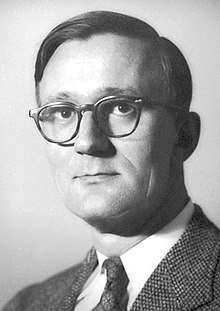Polycarp Kush
Polykarp Kusch (born January 26, 1911 in Blankenburg , Germany , † March 20, 1993 in Dallas , Texas , USA ) was an American physicist and Nobel Prize winner.
Polykarp Kusch came to the USA with his family from Germany in 1912. He received his bachelor's degree from the Case Institute of Technology in 1931 and his master's degree from the University of Illinois at Urbana-Champaign in 1933 . In 1936 he received his doctorate from the University of Illinois on a subject in the field of optical molecular spectroscopy with F. Loomis Wheeler. In 1936 he was an assistant at the University of Minnesota (where he worked with mass spectrometers) and from 1937 an instructor at Columbia University , where he was also involved in military research during World War II. He applied the techniques he learned from microwave electronics to spectroscopy after the Second World War. From 1941 to 1942 he was a development engineer at Westinghouse Electric and from 1944 to 1946 he was a researcher at Bell Laboratories . From 1946 he was associate professor and from 1949 professor at Columbia University, whose physics faculty he headed from 1949 to 1952 and 1960 to 1963. At first he worked closely with Isidor Isaac Rabi at Columbia University . 1969/70 he was Vice President of the University and Dean of the Faculty and 1970/71 Provost. From 1952 to 1960 he was Executive Director of the Radiation Laboratory at Columbia University. In 1972 he became a professor at the University of Texas at Dallas , where he was professor emeritus from 1982. 1952 to 1957 he was a consultant for IBM .
He first worked on nuclear magnetic resonance , with the help of which the magnetic moment of an atomic nucleus can be determined very precisely. Further series of tests to determine the magnetic moment of the electron on sodium, gallium and indium atoms resulted in a deviation from the theoretically expected value. For this discovery, Kusch (together with Willis Eugene Lamb ) received the Nobel Prize in Physics in 1955 . For quantum electrodynamics , which was the only theory that could explain this deviation , this discovery meant the breakthrough to widespread recognition.
Later, Kusch did research on molecular beams in chemical physics.
From 1956 he was a member of the National Academy of Sciences , in 1959 he was elected to the American Academy of Arts and Sciences and in 1967 to the American Philosophical Society . He has honorary degrees from Ohio State University , the Case Institute of Technology, Colby College, and the University of Illinois.
One of his students was Gordon Gould , who was one of the inventors of the laser .
Web links
- Information from the Nobel Foundation on the 1955 award ceremony for Polykarp Kusch (English)
- Polycarp Kush. In: Physics History Network. American Institute of Physics
| personal data | |
|---|---|
| SURNAME | Kush, Polycarp |
| BRIEF DESCRIPTION | American physicist |
| DATE OF BIRTH | January 26, 1911 |
| PLACE OF BIRTH | Blankenburg , Germany |
| DATE OF DEATH | March 20, 1993 |
| Place of death | Dallas , Texas , USA |
